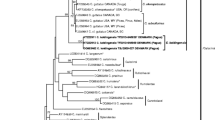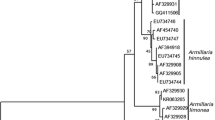Abstract
Lactarius vinosus is often considered as a variety of L. sanguifluus. Morphological (especially macroscopical characters and spore-ornamentation) and molecular arguments (based on ITS-sequencing) are given here to treat it as a separate species. Its relationship to closely related species of Lactarius section Deliciosi is discussed.
Similar content being viewed by others
References
Barla JB (1855) Tableau comparatif des champignons comestibles et vénéreux de Nice, Nice.
Barla JB (1859) Les champignons de la province de Nice et principalement les espèces comestibles, suspectes ou vénéneuses, dessinés d’après nature, Nice.
Basso MT (1999) Lactarius Pers. Fungi Europei, VIII, Mycoflora, Alassio.
Bataille F (1908) Flore monographique des astérosporés. Lactaires et Russules. — Mémoires de la Société d’Émulation du Doubs, 8 sér., 2: 1–45.
Bergendorff O, Sterner O (1988) The sesquiterpenes of Lactarius deliciosus and L. deterrimus. — Phytochemistry 27: 97–100.
Blum J (1976) Les Lactaires. Etudes mycologiques 3, Paul Lechevalier, Paris.
Bon M (1980) Clé monographique du genre Lactarius. — Documents Mycologiques 10: 1–85.
Courtecuisse R, Duhem B (1994) Les champignons de France. Delachaux et Niestlé. Eclectis, Lausanne.
Dähncke RM (1993) 1200 Pilze in Farbfotos. AT Verlag, Stuttgart.
Eberhardt U (2000) Moleculare Analysen zur Verwandtschaft der agaricoiden Russulaceen im Vergleich mit Mykorrhiza-und Fruchtkörpermerkmalen. Doctoral thesis, University of Tübingen.
Ewing B, Green P (1998) Base-calling of automated sequencer traces using phred. II. Error probabilities. — Genome Research 8: 186–194.
Ewing B, Hillier L, Wendl MC, Green P (1998) Base-calling of automated sequencer traces using phred. I. Accuracy assessment. — Genome Research 8: 175–185.
Gardes M, Bruns TD (1993) ITS primers with enhanced specificity for basidiomycetes — application to the identification of mycorrhizae and rusts. — Molecular Ecology 2: 113–118.
Heilmann-Clausen J, Verbeken A, Vesterholt J (1998) The genus Lactarius. Fungi of Northern Europe 2. Denmark.
Kimura M (1981) Estimation of evolutionary distances between homologous nucleotide sequences. — Proceedings of the National Acadademy of Sciences of the USA 78: 454–458.
Konrad P, Maublanc A (1952) Les Agaricales. Tome 2. Paul Lechevalier, Paris.
Kornerup A, Wanscher JH (1962) Farver i Farver. Politikens Forlag, Copenhagen.
Kühner R, Romagnesi H (1953) Flore analytique des Champignons supérieurs. Masson, Paris.
Kuyper TW, Van Vuure M (1985) Nomenclatural notes on Russula. — Persoonia 12: 447–455.
Lalli G, Frizzi G, Pacioni G (2002) Biochemical systematics of some species of Lactarius section Dapetes. — Plant Biosystems 136: 115–122.
Marchand A (1971) Champignons du Nord et du Midi 1. Les meilleurs comestibles et les principaux vénéreux. Perpignan.
Marchand A (1980) Champignons du Nord et du Midi 6. Lactaires et pholiotes. Perpignan.
Marxmüller H, Romagnesi H (1991) Lactarius sanguifluus (Paulet: Fr.) Fr. var. vinosus Quélet. — Bulletin de la Société Mycologique de France 107: Atlas pl. 262.
Moser M, Jülich W (1996) Farbatlas der Basidiomyceten, IV, 14. Gustav Fischer, Stuttgart.
Neuhoff W (1956) Die Milchlinge (Lactarii). In Die Pilze Mitteleuropas Bd. IIb. Julius Klinkhardt, Bad Heilbrunn Obb.
Paulet JJ (1811) Traité des Champignons, Vol. 2, 9th ed.
Posada D, Crandall KA (1998) MODELTEST: testing the model of DNA substitution. — Bioinformatics 14: 817–818.
Quélet L (1881) Quelques espèces critiques ou nouvelles de la flora mycologique de France. Compte rendu de l’Association Française pour l’Avancement des Sciences. — Congres de Reims 1880. 9: 661–675.
Schmitt JA (1974) Chemotaxonomische, morphologische und pflanzensoziologische Studien an mitteleuropäischen Lactarius-Arten der Sektion Dapetes Fr. (Blutreizker). — Zeitschrift für Pilzkunde 39: 219–244.
Swofford DL, Olsen GJ, Wadell PJ, Hillis DM (1996) Phylogenetic interference. In Hillis DM, Moritz C, Mable BK (eds) Molecular Systematics, pp. 407–514. Sinauer Associates, Inc., Massachusetts.
Swofford DL (2002) PAUP*. Phylogenetic Analysis Using Parsimony (* and Other Methods). Version 4. Sinauer Associates, Sunderland, Massachusetts.
Thompson JD, Higgins DG, Gibson TJ (1994) CLUSTAL W: improving the sensitivity of progressive multiple sequence alignment through sequence weighting, position specific gap penalties and weight matrix choice. — Nucleic Acids Research 22: 4373–4680.
White TJ, Bruns T, Lee S, Taylor JW (1990) Amplification and direct sequencing of fungal ribosomal RNA genes for phylogenetics. In Innis MA, Gelfand DH, Sninsky JJ, White TJ (eds) PCR Protocols: A Guide to Methods and Applications, pp. 315–322. Academic Press, Inc., New York.
Author information
Authors and Affiliations
Corresponding author
Rights and permissions
About this article
Cite this article
Nuytinck, J., Verbeken, A. Lactarius sanguifluus versus Lactarius vinosus — Molecular and morphological analyses. Mycol Progress 2, 227–234 (2003). https://doi.org/10.1007/s11557-006-0060-5
Accepted:
Issue Date:
DOI: https://doi.org/10.1007/s11557-006-0060-5




